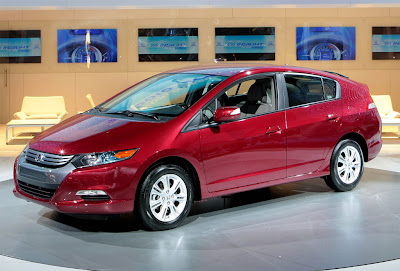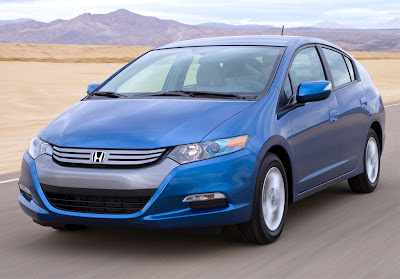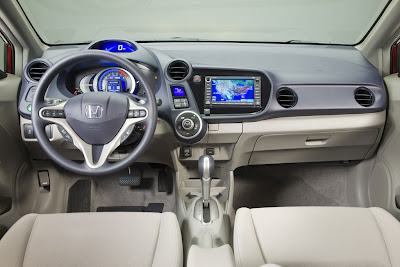
Our spoiled European brethern will soon be able to get the slinky Jaguar XF four-door coupe in diesel trim with 440 lb-ft of torque, quicker-than-V8 performance and 35 MPG US.
In theory, the 2010 Jaguar XF S was fitted with a diesel V6 in order to help raise the brand's eco cred and lower their C02 emissions. In reality, the XF S gets enough torque to push the luxury saloon to the 60 MPH mark in less than six seconds, faster than the normally aspirated V8 version and less than a second slower than the supercharged V8.
The new 3.0-Liter twin-tubro AJ-V6D engine offers a 16% increase in power and 15% increase in torque, helping to lower the 0-60 MPH time by nearly two seconds and stretching the top speed to the 155 MPH electronically limited level while at the same time increasing mileage by 12% over the smaller engine. Me-ow. Of course, you can't get one here.
Full details, if you can stand it, in the press release below.
THE NEW JAGUAR XF DIESEL S
"The new XF V6 Diesel S – combining superb performance and excellent fuel economy – sets the pace with acceleration from 0-60mph in 5.9 seconds, a maximum speed of 155mph, yet delivers an average fuel consumption of 42mpg and CO2 emissions of 179g/km: Truly the best of both worlds!"
Mike O'Driscoll, Managing Director, Jaguar Cars
THE NEW XF DIESEL S – In Brief
* The most advanced, powerful and efficient Jaguar diesel ever
* New 275PS high-performance XF Diesel S featuring Jaguar's new AJ-V6D Gen III S 3.0-litre diesel engine delivering a massive 600Nm of torque
* 0-60mph in just 5.9 seconds, 50-70mph in just 3.2 seconds and a maximum speed of 155mph, yet combined fuel economy of 42.0mpg – 12 percent better than the acclaimed 2.7-litre V6 diesel engine
* Emits just 179g/km – a 10 percent reduction in CO2. Conforms to EU5 emission regulations using conventional exhaust after-treatment
* 33 percent more powerful and 61 percent more torque from 1500rpm than the 2.7-litre V6 diesel
"With CO2 emissions of 179g/km, 42mpg average fuel economy and 0-60mph acceleration in 5.9 seconds, this is another great example of Jaguar delivering unrivalled performance while at the same time taking the level of refinement in diesel engines to a whole new level."
Mick Mohan, Jaguar Programmes Director
When it was introduced last year, the XF was recognised as a dramatic expression of a bold new Jaguar design language. It also soon became apparent that here was a car where the driving experience exceeded the expectations created by the striking appearance. Now, the new XF Diesel S takes this driving experience to new levels, shifting the balance even further towards dynamic performance while still retaining the XF's core values as a refined and luxurious sports saloon.
Distinguished by 19 inch wheels, an aerodynamic boot lid spoiler and discreet 'S' badging, the car that defines Jaguar sporting luxury is even better for the 2010 model year, with a stunning new high-performance diesel. Powered by a 275PS engine, the Diesel S gives the XF outstanding levels of performance, accelerating from 0-60mph in just 5.9 seconds, 1.8 seconds quicker than the excellent 2.7-litre model. In-gear acceleration is equally impressive, with a 50-70mph time of just 3.2 seconds. Maximum speed is electronically limited to 155mph.
Featuring parallel sequential turbochargers to help deliver the high levels of power and torque seamlessly and with effortless flexibility, this engine is perfectly matched to Jaguar's sophisticated six-speed ZF 6HP28 automatic transmission.
"The new parallel sequential turbocharger system on our new V6 diesel delivers V8 levels of performance from very low revs. It's a power unit that offers superb flexibility and remarkably low fuel consumption and emissions, while building on the refinement that has become a trademark of our Jaguar diesel engines."
Ron Lee, Group Chief Engineer, Powertrain
There is an equally impressive 240PS version of the new 3.0-litre engine available too, which produces 16 percent more power and a 15 percent increase in torque over the 2.7-litre diesel, allowing the XF to reach 60mph in 6.7 seconds. Its 50-70mph time of just 3.7 seconds is only fractionally slower than the 275PS Diesel S model. Maximum speed is 149mph. And like the 275PS engine, these great performance leaps are achieved with combined average fuel consumption of 42.0mpg – an improvement on the 2.7-litre diesel of over 10 percent – and a CO2 emissions rating of only 179g/km.
There are also significant trim and specification changes – including many new features – and the introduction of a new luxurious Portfolio derivative as part of the core range. For Jaguar and the new 2010 model year XF, the high-performance diesel has truly arrived.
The acclaimed XF 2.7 Diesel has won several accolades, including in the UK What Car magazine's 'Diesel Car of the Year' and 'Car of the Year', What Diesel magazine's 'Diesel Car of the Year' and the Association of Scottish Motoring Writers' Best Diesel of 2008.
The new AJ-V6D Gen III engine – In detail
Drawing on the experience gained in designing the original, acclaimed 2.7-litre engine, the new 3.0-litre AJ-V6D Gen III diesels demonstrate that it is possible to deliver improved performance, while reducing CO2 emissions and fuel economy. In the XF, the new engine produces 10 percent less CO2 than the 2.7-litre, while power has increased by 33 percent in Diesel S guise. As well as tackling CO2, the new 3.0-litre engines meet the forthcoming EU5 regulations, due to come into force at the start of 2011. And these great performance leaps are achieved with combined average fuel consumption in both models of 42.0mpg – an improvement on the 2.7-litre engine of 12 percent.
Twin-turbos – maximum efficiency, instant response
A key feature of the new engine is the unique, parallel sequential turbocharger system, the first of its type to be fitted to a V-engine anywhere in the world. Delivering high torque throughout the entire engine rev range, improved throttle response and low CO2 emissions, the twin-turbochargers work sequentially to deliver unrivalled response and best-in-class torque – an impressive 61 percent more than the 2.7-litre diesel from 1500rpm – while packing a huge punch at higher engine speeds.
For most day-to-day driving, including motorway cruising, a responsive, variable-geometry primary turbocharger does all the work, while the smaller, fixed-geometry, secondary turbo is dormant, saving energy and improving efficiency. When the engine revs climb above 2800rpm, the secondary turbo is brought on line within 300 milliseconds, smoothly and seamlessly boosting the engine output with no discernible turbo-lag or power-step.
Driving a turbocharger requires pressure from the exhaust, creating pumping losses in the engine and increasing fuel consumption. To alleviate this, valves under the control of the engine management system isolate the secondary turbocharger both from the exhaust stream and the engine inlet tract when it is not required.
Some twin-turbo systems rely on a smaller turbo for primary use, only using a larger turbo when higher power is required. Though effective, this has the disadvantage of raised exhaust pressure and increased pumping losses. The Jaguar system uses a larger, variable-geometry turbocharger more of the time, which not only reduces pumping losses, but also improves fuel consumption and CO2 emissions.
Jaguar engineers particularly focussed on the issue of turbocharger 'lag' at low engine speeds. The new AJ-V6D Gen III 3.0-litre diesels significantly out-perform their rivals by delivering 500Nm of torque in only 500 milliseconds from idle.
Third-generation commonrail
A new commonrail fuel-injection system delivers up to five injections on each cycle at a pressure of 2000bar. Each injector tip is perforated by seven holes through which finely atomised fuel is sprayed into the cylinders. The high-pressure injection increases power, improves economy and reduces both CO2 and particulate emissions. New, third-generation high-speed piezo injectors allow up to five precise injection events during each combustion cycle, minimising engine combustion noise.
Piezo crystal 'packs' operate each injector by expanding when an electric current is passed through them. They react virtually instantaneously but can make a distinctive click when fired, which can add to diesel engine noise at idle. The crystals in Jaguar's new injectors are fitted nearer the tip, meaning they are mounted deeper inside the engine providing better sound insulation and quieter operation.
Another new feature of the third-generation fuel-injection system is the metering mode. Traditional diesel commonrail fuel pumps oversupply the injectors, with the surplus being returned to the fuel tank. During this process, fuel temperature increases and cooling it again consumes considerable amounts of energy. In metering mode, the pump delivers fuel to the injectors only at the rate required. Consequentially, there is no rise in fuel temperature and no wasted energy.
Compact, light and clean
The two cylinder heads, with four valves per cylinder, are made from aluminium and the cylinder block is made from compact graphite iron (CGI). The higher tensile strength of CGI makes it possible to cast a smaller block; some 80mm shorter than a conventional 'grey' cast iron equivalent.
The new, water-cooled, exhaust gas recirculation system (EGR), important for reducing pumping losses and emissions of NOx in a diesel engine, is more efficient and consumes less power than the 2.7-litre unit. The valves that allow exhaust gas into the system are located on the 'hot side' of the engine nearest the exhaust manifolds; these valves never cool while the engine is running, so there is no condensation of combustion deposits which occurs on engines fitted with 'cold side' valves, hence the EGR system always works at maximum efficiency. Since the EGR cooling is so effective, exhaust gasses can bypass the system and return to the exhaust pipes, allowing faster engine warm-up from start-up and reducing emissions still further.
EU5 emissions regulations have been achieved ahead of the 2011 legislative timetable using conventional diesel oxidation catalysts and diesel particulate filters (DPFs). NOx levels are reduced at source through the combustion system design, the addition of the new commonrail injection system and the new EGR system with by-pass. As a result, specialised NOx exhaust after-treatment is unnecessary, avoiding a potential cost and the need to use additional precious metals in the exhaust system.
Remarkably quiet for a diesel
The CGI cylinder block and new piezo injectors reduce combustion noise in the engine. Multiple, precise injections of fuel on the combustion stroke also reduce combustion noise and all engine covers including camshaft covers, front covers and the sump have been optimised to subdue radiated noise. Engine enclosures have been ribbed to minimise radiated noise and the sump pan is manufactured from sound deadening steel (SDS), comprising a polymer layer sandwiched between two layers of steel.
Internal friction, a major contributor to unnecessary fuel consumption, has been addressed by careful optimisation of the crankshaft, valves and pistons. All these features combine to make the new Jaguar AJ-V6D Gen III engines amongst the quietest premium diesels on the market.
A major step forward
With its parallel sequential turbocharger system, third-generation commonrail fuel injection system and fully optimised EGR system, the new 3.0-litre AJ-V6D Gen III diesel sets new class standards when it comes to power, response and refinement in the premium diesel segment.
"The new XF challenges the rules and redefines Jaguar sporting luxury. Our designers and engineers have worked together to develop elegant, inspired solutions to complex technical challenges. It's a simple but very effective philosophy and the result is great new products like the new 3.0-litre diesel XF."
Mike O'Driscoll, Managing Director, Jaguar Cars
[Source: Jaguar]



 Welcome to Down On The Street, where we admire old vehicles found parked on the streets of the Island That Rust Forgot: Alameda, California. How about a turbocharged French sports sedan from the Reagan Era?
Welcome to Down On The Street, where we admire old vehicles found parked on the streets of the Island That Rust Forgot: Alameda, California. How about a turbocharged French sports sedan from the Reagan Era? 


 What do you call a van full of eight Frenchmen? We don't know either, but Peugeot will soon provide a vehicle that will help whisk your way toward the punchline. Spy shooters have snagged a long wheelbase version of Peugeot's 3008 MPV. The not-a-van should offer comfortable accommodations for five plus stuff, or a content quintet joined by a quarrelsome troika in the final row. The LWB 3008 is expected to be officially unveiled at the Frankfurt Motor Show, and aside from the extra stretch between the axles, there's little difference from the regular 3008. PSA hardware is underneath, some pieces being shared with the Citroen C4 Picasso, and since the short-wheelbase 3008 is a handsome wagonycrossoveryvanny thing, a little stretch to the styling shouldn't hurt.
What do you call a van full of eight Frenchmen? We don't know either, but Peugeot will soon provide a vehicle that will help whisk your way toward the punchline. Spy shooters have snagged a long wheelbase version of Peugeot's 3008 MPV. The not-a-van should offer comfortable accommodations for five plus stuff, or a content quintet joined by a quarrelsome troika in the final row. The LWB 3008 is expected to be officially unveiled at the Frankfurt Motor Show, and aside from the extra stretch between the axles, there's little difference from the regular 3008. PSA hardware is underneath, some pieces being shared with the Citroen C4 Picasso, and since the short-wheelbase 3008 is a handsome wagonycrossoveryvanny thing, a little stretch to the styling shouldn't hurt. 







 (Credit: Kia Motors)
(Credit: Kia Motors) 

































